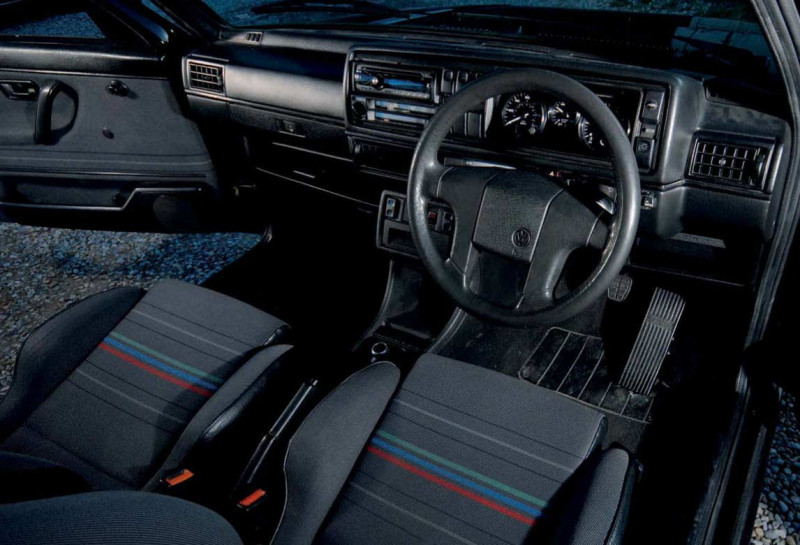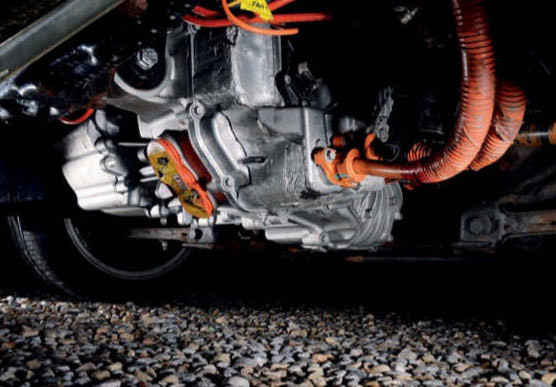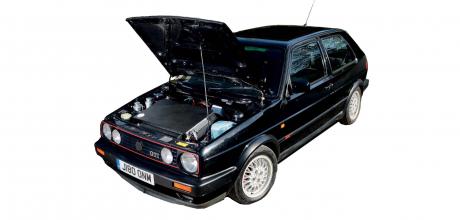Tesla Model S powered 270bhp electric Volkswagen Golf Mk2
This is the first Tesla-swapped Mk2 to grace these pages, but at £60k the conversion isn’t cheap. We sent Jon Cass to go sample the car and find out if this is genuinely the future of modified VWs. Words & photos: Jon Cass
At first glance this may seem like a standard Mk2 Golf GTI and in many respects it is. The suspension, brakes, exterior, much of the interior and even the BBS rims will be familiar to past and present owners of a Mk2, myself included. Yet, the remainder of this innocent looking Golf couldn’t be more different to any other of the multitude of Mk2s that rolled off the production line in Wolfsburg decades ago. The lack of exhaust and curious flap where the VW badge once lived perhaps give the game away that this car is not quite all it seems and there’s no clutch or gears too. And its distinctly quiet, just a gentle hum instead of the usual rasp or growl. Yes, if you hadn’t already guessed, this is an electric Mk2 Golf, powered by a 270bhp Tesla DU motor, no less!

When I first began writing features some 20 years ago, this whole idea would have been unthinkable, its only in recent times we’ve become accustomed to the idea that electric cars for many are a viable way of getting around and may one day outsell their petrol or diesel fuelled counterparts. We won’t get into the EV, hydrogen or synthetic fuel debate here, but it looks like electric cars are here to stay, for the foreseeable future at least. So why not convert one of our best loved classics to run a modern EV powertrain, you’d have the classic looks combined with zero emissions, cheap running costs and endless bags of torque to boot?
When Kit Lacey at Boroughbridge based eDub Services received a call from a potential customer to convert a standard Mk2 Golf GTI to run a Tesla system earlier this year, he couldn’t wait to make a start!
“We’d done conversions on Porsche 911s, Datsun 240Zs and plenty of VW Type 2 campers but a Mk2 Golf is a much smaller vehicle to work on,” Kit tells us, “there’s less space to fit all the required components and its more modern which meant considering 12v wiring, heating, power steering and brakes. Unlike previous conversions we’d carried out, a Golf is also front wheel drive too!”

The initial step for this mammoth project is deciding where the motor will sit, and the Golf’s front wheel drive layout dictated this had to be low down within the engine bay.
“We had to rotate the drive unit 180 degrees for it to fit, which involved some internal modifications to the DU too,” Kit explains, “the motor mount is then designed and finalised, ready for fabrication.” eDub services with their partners, OPTO Innovation design, print, fold and paint their own steel motor subframes and use aluminium battery boxes, containing internal skeletons to house the batteries safely. This Mk2 runs a small, formerly rear drive unit as found in a Tesla Model S or Model X rated down to 162bhp, 60% of its original power – though this can be adjusted to suit. The chosen unit itself is stripped and tested by Zero EV in Bristol where they install their own logic board. Being an EV there’s no need for a bulky gearbox, there’s just a selection for drive (forward), neutral and reverse while the custom drive shafts connect to the Golf’s original stub axles.

The next step involves 3D scanning the entire vehicle to work out where the battery packs will be housed and as we all know, these often take up plenty of space! “We not only have to think about where the packs will fit, but also how they will be assembled,” Kit continues, “we prefer to assemble as much of the high voltage pack as possible on the bench to ensure the system is connected safely, ready for it to be lowered into position in the vehicle.” eDub Services use brand new CALB batteries as they are smaller and easier to package than standard Tesla equivalents, as they’re brand new the new owner can be confident there is plenty of life left in them too. The split battery pack at 350v nominal in this Mk2 is located 50% in the boot complete with its lowered floor while the remainder sits under the bonnet above the drive unit. “Once the battery locations are finalised, we then choose locations for other bulky items such as the charger, the DCDC and any heater integration,” Kit adds The conversion process doesn’t end there as the engine bay also houses a custom control box to pick up on the 12v circuitry and safety control of all other aspects of the vehicle with relays and protection fuses.

The power steering is now driven from an electric pump as is the brake servo system. Intricate cooling systems for the drive unit and batteries are then installed, also located within the engine bay. Incredibly, this clever use of hidden fabrication work and available space means the Golf still has a usable boot while outwardly it remains standard, it’s amazing how much you can fi t in a Mk2!
Step inside and again things initially don’t look that different from a standard Mk2 GTI, the seats, dashboard and even the steering wheel remains familiar. Begin to take a closer look and you’ll notice a motor temperature dial now sits where the gearstick once lived and there’s no clutch pedal either. A new floor mounted electric throttle and brake pedal are all that’s now needed! Housed within the Mk2’s standard dashboard is an added starter switch and heater switch, while custom dials show MPH, Battery state of charge and an Amp gauge replaces the rev counter. It’s an incredibly well thought through conversion throughout, remaining sympathetic to VW’s original.
So, what’s it like to drive? The immediate reaction is to ask yourself, or on this occasion, Kit if the car is switched on! The lack of exhaust note, even at idle is a little bizarre and many could justifi ably argue this significant omission would ruin the whole experience of driving a Mk2 GTI. Yet once on the move, the familiar road and tyre noise returns along with the Tesla’s gentle hum.
The huge floor mounted throttle pedal, not dissimilar to a Mk1 Citi and the lack of clutch or gearstick takes some getting used to, but after a short while you become accustomed to a more refined experience on the open road. As this conversion uses standard Mk2 Golf suspension and brakes combined with a 50/50 distribution of EV components, the trademark Mk2 GTI handling thankfully remains and soon you’re enjoying the whole experience. The power steering is weighted perfectly, and the low body just seems to hug the corners as you’d expect. Kit tells us the kerb weight now stands at 1280kg, only 200kg or so heavier than a standard Golf and certainly nowhere near as hefty as a standard Tesla. Don’t forget there’s now no petrol tank to drag around which goes some way to compensate. The EV powertrain comes with the bonus of brisk acceleration, around 8 seconds to 60mph with the power set to 60% Kit reckons. With bags of instant torque from standstill and no precious time lost depressing the clutch or changing gear, I’d say Kit’s a little modest with that 0-60 figure, for sure with 100% power this would be a mightily rapid car!
There are some downsides like you’d expect from owning any EV. At £60k this conversion isn’t cheap, but then it’s not something most of us would have the confidence or knowhow to do ourselves on a spare weekend. The design, expertise, and fabrication work by eDub Services combined with that huge inventory of electrical components in reality justifies the price tag, this is a project that could go very badly wrong if you weren’t sure exactly what you were doing!
The real-world range is around 170 miles, so you’d need to plan those journeys carefully. Having said that, the batteries can be fully recharged from zero to 100% in an hour using a CCS rapid charger. This particular car uses CHAdeMO rapid charging, but future versions will use a CCS system and the location of the charger will still attach to a socket within the front grill behind the VW badge. Just imagine how much attention that could bring when filling up! Maybe, the VW designers had planned ahead here? A home charger would need 8 hours to see the batteries at full capacity while recharging from a 3-pin plug would need double that time. If you’re not planning on more than a 170-mile round trip, then there’s obviously nothing to worry about.
Kit also points out they’ve not come across any problems insuring their converted EVs, no additional testing is needed, and they can even help changing to a new V5C which comes with the bonus of free road tax. “We now have the design, fabrication and assembly method to use again in other Mk2 Golfs and similar cars, so this is a conversion we could easily carry out again,” Kit points out. In fact, there are plans to use Telsa’s Model 3 motor with an identical power output in future FWD conversions as this could be mounted in its original position, simplifying the whole process. The swap to CCS charging would also see all necessary charge sockets located behind the front VW badge, which doubles as a conveniently placed sizeable flap.
While we aren’t expecting vast numbers of fossil fuel powered Mk2s forming an orderly queue in readiness for their EV transplants, we’d anticipate this type of conversion to become more commonplace for many classic car fans. Okay, it might not be for everyone, but as the world’s politicians and Greta continue to ask us to step away from our gas guzzlers and into EV’s, perhaps a future proof electric powered Mk2 Golf begins to make sense. Our perfect car of the future could still be the same car we drove in 1991.
SHOUT: eDub Services (www.edubservices.co.uk), Dan at OPTO Engineering www.optoinnovation.co.uk, Chris at Zero EV and the customer for the opportunity
eDUB SERVICES
North Yorkshire-based eDub Services was formed back in 2013 when Kit Lacey had a crazy idea, if you can swap an engine in a VW Type 2, why can’t you make it electric? “Once I had the idea, I couldn’t let it go,” Kit explains, “I purchased a conversion kit from the States and the rest is history!” In a bid to make a return on this substantial investment, Kit converted a VW type 2 camper to electric and offered it for hire, initially naming his company eDub Trips. “I just worked in my spare time back then with my Mum and Dad as partners,” he adds. Since then, eDub Services has grown substantially with Kit’s brother Joss now acting as senior technician, Dec Meecham as trainee technician and Caroline Campbell who takes care of the admin, joining the crew. “Danny Floyde from electric off road also comes to us to help with some of our fabrication work,” Kit tells us, “it hasn’t all been plain sailing, there have been many nights I’ve been stranded on the hard shoulder waiting for recovery when a test didn’t quite go to plan, but I’m so glad I persisted with it all!” Much of the assembly work is conducted in house, with fabrication carried out by OPTO Innovation in Derby while Bristol based Zero EV has become the main supplier of components required to carry out an EV conversion.
Currently eDub Services have some thirteen projects on the go including a Porsche 911, BMW 700, numerous camper vans, and a VW Variant so they’ll certainly be very busy for some time to come. Kit’s knowledge and enthusiasm for EV conversions is nothing short of mind blowing so if you’re currently considering the option of converting your classic into an EV, we can’t think of anyone better to approach than eDub services. For more info visit edubconversions.co.uk
DUB DETAILS
- MOTOR: Tesla Model S/X 270bhp motor rated to 162bhp (60% power), motor rotated 180 degrees with internal modifications for FWD and mounted on steel subframe, CALB batteries (50% under bonnet/ 50% in boot), petrol tank removed/ lowered boot floor, custom drive shafts with Mk2 Golf stub axles, aluminium battery boxes, split battery pack at 350v, original 12v battery retained, custom control box for 12v circuitry with relays and fuses, electric power steering, additional cooling for drive unit and batteries
- CHASSIS: 14” BBS wheels with standard Mk2 Golf GTI suspension and brakes. Brake servo system via electric pump
- EXTERIOR: Standard big bumper Mk2 GTI, socket for rapid charger in place of VW grille badge, socket for home charger behind fuel filler flap
- INTERIOR: Dash-mounted start and heater switch, custom dials showing MPH/ battery state of charge (SOC), amp gauge, motor temperature dial in gearstick location, drive/neutral and reverse gears, floor mounted electric throttle pedal
PERFORMANCE
- 170-mile range
- 0-60 in 8-seconds
- 1 Hour recharge from 0-100% with CCS rapid charger
- 8 hours recharge 0-100% home charger
- 16 hours recharge 0-100% 3 pin plug
Despite the lack of an engine, bay is now loaded with batteries on top and the Tesla motor lurks beneath them



very cool idea